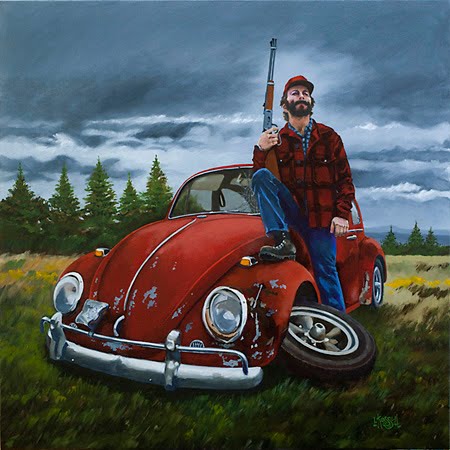“So clever and beautifully painted. Makes me think back to art history classes with a fun twist.” -- K.P.
 |
Inacchronisms™ Show visitors chose Framer’s Daughter (inset, derived from William Bouguereau’s Peasant Woman) one of their favorites.
|
 |
Inacchronisms™ Show visitors chose Framer’s Daughter (inset, derived from William Bouguereau’s Peasant Woman) one of their favorites.
|
 |
Three of Larry Kassell's 16 pastiche paintings include Monet Lisa, Rembrat van Tagger and The Framer’s Daughter – featured the month of October 2011, at Corban University Psalm Visual Arts Gallery.
|
 |
| Ansel Adams at work, Bear Valley, California, May 1971. |
 |
| Sunrise, Yosemite National Park, May 1971. |
 Mary Laura Gardner encourages a student during a lesson. Oil on canvas / 14h x 11w |
 |
Blackened Catfish / original oil painting on canvas / ©2011 Larry Kassell / 24 h x 20 w |
Welcome to my glob, Volume 1, Number 1. There could be erors.
I was told to write from what I know, and I know something about art, but certainly not everything I should about the subject. And that’s why I’m counting on feedback from friendly friends and (constructively) critical critics.
As a painter I favor realism with maybe a touch of humor — from others as well as myself. I believe we should paint to the best of our ability each time, and then build on that to become better — eventually achieving artist stature. Is randomly smearing paint on a canvas declaring: “It came from in here” (pointing to the heart area) the best use of God-given talent and resources?
I was not blessed into a wealthy family, nor folks that encouraged my art, nor did I have the talent to earn an art scholarship. What I learned was gleaned from art history books and studying the techniques of the Old Masters.
When I graduated from North Salem (Ore.) High School, I enlisted in the U.S. Air Force and was sent to electronics school where my classmates were already ham radio operators and already knew the color codes on resistors. That I knew the primary and secondary color wheel was of no consequence. In the little time off I had, I’d paint oil portraits of classmates’ girlfriends from a tiny photograph http://larrykassell.com/about . I learned the tough lesson that if it did not look like their love interest, or better, I didn’t get paid. In the mix of subjects I painted portraits of a captain and a major. The Air Force then decided I’d make a better Illustrator than Missile Maintenance Technician, so I painted fighter jets in acrylics and prepared informational slide shows for the remainder of my commitment which concluded in South Korea. At the Base Exchange at Osan, Korea, cameras were duty-free and I had access to a darkroom, so I retired my paintbrushes for a time and pursued my new found interest in photography. I admired the crisp landscape work of Ansel Adams, struck up a postal correspondence with him, and in 1966 purchased one of his noted photos — Aspens, New Mexico.
After four years of military service, I worked for the State of Oregon Education Division as a Graphic Artist, the (Salem) Statesman-Journal newspaper advertising department as an ad designer, the Silverton Appeal-Tribune newspaper as Advertising Manager, State of Oregon Employment, again as a Graphic Designer, and a now defunct graphics firm in Salem before launching my own design, commercial photography, publication design, and humorous illustration studio in 1976. We pretty much have to do-it-all to stay in business in a town the size of Silverton, Oregon. April 2011 marks my 35th year as Kassell Concepts. I photograph, write, then design ads, brochures and booklets.
I enjoy humorous illustration (cartooning), because humor and caricatures often best drive home a point. Photography is especially rewarding because a photographer has to actually be present at the event to capture a photo, and sometimes that requires extensive travel. In forty-plus years of photography I’ve met so many interesting people and witnessed so many gorgeous sunsets that I can’t keep it inside. A photo in an album, attic, or still in a camera or computer is like the tree that falls in the forest and nobody hears. So, I choose to share my illustrations and photos — but like home movies, they’d better be interesting. I published two photo books of my hometown, Silverton Sampler (1972) and Silverton Sampler II (2003).
As much as I love photography, film and darkrooms have gone the way of tail fins on cars (remember 1957?), and digital photography and its editing programs have made practically everyone a photographer. In December, 2007 I bought some canvases, an easel, a few brushes and a selection of Gamblin oils and launched my third or fourth career. Now with our six kids out of the nest, and with my wife Julia’s blessing, I paint, paint, paint — whenever I find time — like when I was in the service more than forty years ago.
Favorite artists
Seriously. The best artist in history was Norman Rockwell. The best impressionist was Bernie Fuchs. My favorite living artist: James C. Christensen. Others, living and not-so-much, are Adolphe William Bougerau, Nelson Shanks, Jacob Collins ... all traditionalists.
The best artist in Silverton, Ore. is probably the lady who decorates cakes at Roth’s Fresh Markets.
What I’ve been up to
This painting is from a photograph taken many years ago of a friend posing with my wife Julia’s VW Beetle, Susie. “The Controlled Beetle Hunt of 1968” takes a humorous poke at Oregon’s SUV and pickup owners who see little foreign nuisances on the road as fair game. A brush-and-ink rendering of this painting will be featured in an upcoming book I’m working on. I’ll keep you updated.
